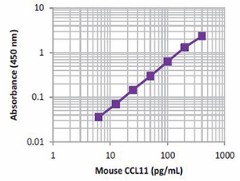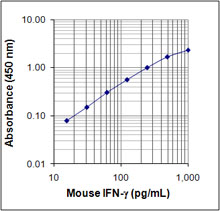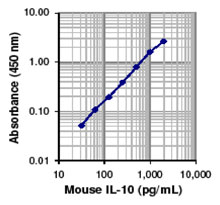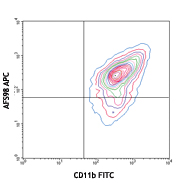- Regulatory Status
- RUO
- Other Names
- Eotaxin, Eotaxin-1, SCYA11
- Ave. Rating
- Submit a Review
- Product Citations
- publications

| Cat # | Size | Price | Quantity Check Availability | Save | ||
|---|---|---|---|---|---|---|
| 443907 | 1 Pre-coated Plate | £317 | ||||
CCL11, also known as Eotaxin, is a small cytokine belonging to the CC chemokine family. The full length of CCL11 is 97 amino acids (aa) with a 23 aa signal peptide, which is cleaved to generate a 74 aa mature protein. The molecular mass of CCL11 is about 10 kD, and its gene is located on the q arm of chromosome 17. CCL11 expression has been found in normal tissues such as smooth muscle and small intestine. Endothelial cells, smooth muscle cells, epithelial cells, alveolar macrophages, and eosinophils are known to produce CCL11. Mouse CCL11 shares a 61% and 96% amino acid sequence identity to both human and rat, respectively.
CCL11 is produced when inflammatory cytokines, such as IL-5 and TNF-a, stimulate lung endothelial cells, fibroblasts, and smooth muscle cells in response to allergens. As a potent eosinophil chemoattractant, via binding to its major receptor, CCR3, CCL11 efficiently induces the accumulation of eosinophils, which is a response associated with allergic inflammation. Therefore, atopic dermatitis, asthma, and parasitic infections are a few of the eosinophilic inflammatory diseases directly related to CCL11. In addition, CCL11 induces the formation of blood vessels and other angiogenic responses which are accompanied by inflammatory infiltration and is also involved in regulation of tumor development.
The LEGEND MAX™ Mouse CCL11 ELISA kit is a Sandwich Enzyme-Linked Immunosorbent Assay (ELISA) with a 96-well strip plate that is pre-coated with a rat monoclonal anti-mouse CCL11 antibody. The detection antibody is a biotinylated goat polyclonal anti-mouse CCL11 antibody. This kit is specifically designed for the accurate quantitation of mouse CCL11 from cell culture supernatant, serum, plasma, and other biological fluids. This kit is analytically validated with ready-to-use reagents.
Kit Contents
- Kit Contents
-
- Anti-Mouse CCL11 Pre-coated 96 well Strip Microplate
- Mouse CCL11 Detection Antibody
- Mouse CCL11 Standard
- Avidin-HRP
- Assay Buffer B
- Wash Buffer (20X)
- Substrate Solution F
- Stop Solution
- Plate Sealers
Product Details
- Verified Reactivity
- Mouse
- Application
-
ELISA
- Product Citations
-
- Sensitivity
- 0.825 ± 0.386 pg/mL
- Standard Range
- 6.25 - 400 pg/mL
- Materials Not Included
-
- Microplate reader able to measure absorbance at 450 nm
- Adjustable pipettes to measure volumes ranging from 1 µL to 1,000 µL
- Deionized water
- Wash bottle or automated microplate washer
- Log-Log graph paper or software for data analysis
- Tubes to prepare standard dilutions
- Timer
- Plate Shaker
- Polypropylene vials
Antigen Details
- Biology Area
- Angiogenesis, Cell Biology, Immunology, Neuroinflammation, Neuroscience
- Molecular Family
- Cytokines/Chemokines
- Gene ID
- 20292 View all products for this Gene ID
- UniProt
- View information about CCL11 on UniProt.org
Related FAQs
- In your LEGEND MAX™ ELISA Kits, there is a step that calls for washing the plates before adding sample. What is the purpose of this step?
-
We typically use a stabilizer for pre-coated plates. The additional washing step is designed to remove these components before you start the assay. If you do not perform the washing, the effect on assay performance is negligible.
- I have multiple LEGEND MAX™ ELISA kits that I want to run simultaneously. Can I use the same wash buffer for all the kits?
-
The wash buffer provided in all our LEGEND MAX™ kits is the same and the part numbers on the wash buffer bottles in these kits should be identical. For ELISA MAX™ Deluxe and ELISA MAX™ Standard Sets, we provide a recipe for the wash buffer on each kit’s technical data sheet. This recipe is the same for all ELISA MAX™ sets.
- For some of your ELISA kits, why do my serum samples require dilution with assay buffer?
-
In some cases, dilution with assay buffer is required to minimize the matrix difference between the samples and the standards to achieve better accuracy.
 Login / Register
Login / Register 













Follow Us